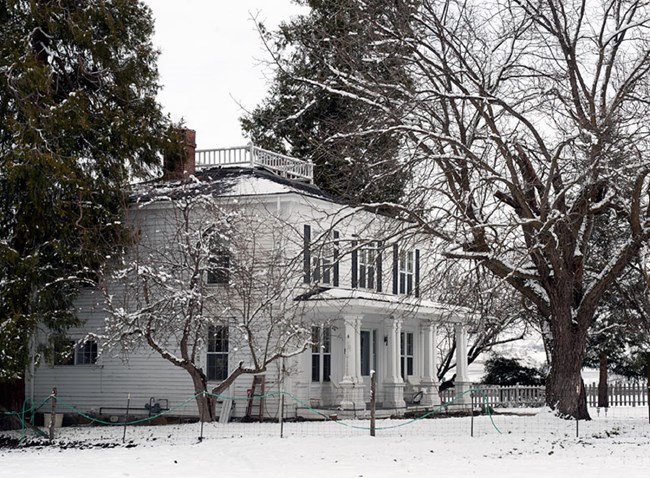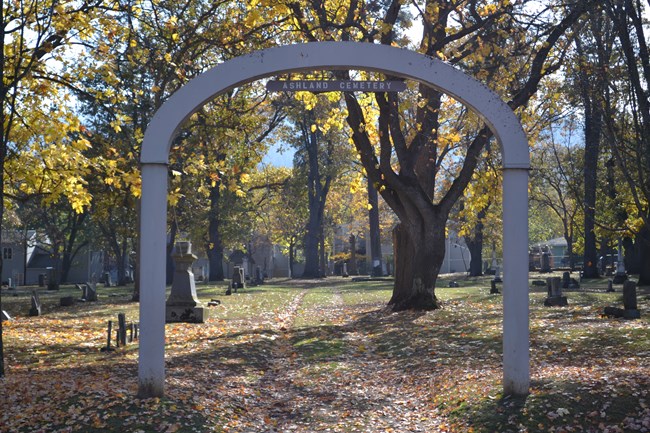Last updated: August 9, 2020
Article
Applegate Trail Settlement

The original Oregon Trail to the Willamette Valley was extremely hazardous and in 1846 Jesse Applegate led a small group of trailblazers in search of a southern route that did not require facing the challenge of the mighty Columbia River where so many pioneers had perished. The Applegate Trail, also known as South Emigrant Road, they opened up was indeed a safer way that traversed the Rogue River Valley. Applegate and his companions did not linger, however, but returned to the Willamette Valley settlements they already knew. This situation would soon change as a result of federal legislation and gold fever.
The Donation Land Law, passed in 1850, provided public land to settlers in the Oregon Territory. It allowed a single male settler to claim 320 acres and a married couple 640 acres (half to be held by the wife). A Donation Land Claim could be filed by any citizen of the United States who had declared intentions before December 1, 1850, and who had resided on and cultivated the land for four consecutive years. Long before the railroad brought prosperity to Ashland, encouraged by this federal legislation, the earliest European settlers in the Ashland area came seeking agricultural land. Although most of their original homes are gone now, the John P. Walker House remains as a reminder of those days. The 1849 California Gold Rush boom moved north and when gold was discovered in Jackson County, miners came, along with the businesses to support them.
At first Ashland, like so many western towns, was an all-male enclave. Robert Hargadine and Abel Helman filed the first Donation Land Claims. Helman had mined in California with Eber Emery; together they built the first sawmill in the valley, powered by water from Ashland Creek. After becoming satisfied with the prospects they found here, men with families in the east returned to bring them to Ashland. In April 1853, Isaac Hill brought his family overland by wagon. His wife Elizabeth was the first white woman to arrive--soon to be joined by others in a familiar pattern of western settlement.

Because of Ashland's proximity to water power beside Ashland Creek, among the town's first enterprises was milling. The lumber, woolen, and flour mills built near today's Plaza accounted for the town's being designated as "Ashland Mills" when the first post office was established in 1855. The Plaza also was conveniently close to the Stage Road (as today's Main Street was then called). This meant that supply wagons had easy access to the north-south route also used by passenger stage coaches.
Soon the hills above Ashland became dotted with orchards as nurserymen came to explore the possibility of growing different kinds of fruit in this climate. Perhaps the experience of Orlando Coolidge best exemplifies this endeavor. In 1866 Coolidge, who had established the first plant nursery in Jackson County in 1862, planted acres of almonds in the hills above town. Although pears eventually became the fruit of choice in this climate, the Orlando Coolidge House (one of the mansions at the north end of historic Ashland known locally as "The Three Sisters") stands as a monument to his success. The other two adjoining residences, The Isaac Woolen House and The W. H. Atkinson House, were homes of families active in the years during which Ashland changed from a small farming supply center to a functioning business and cultural community, supporting churches, a bank, and a newspaper.
Early settlers in the west depended upon fraternal orders to provide social activity and a sense of community; they acted as burial societies as well (part of Mountain View Cemetery was developed by the Independent Order of Oddfellows). In Ashland one of the outstanding examples of the buildings constructed by fraternal groups to house their activities is the hall of the Independent Order of Oddfellows (IOOF Building), begun in 1879.
Although most of the homes they constructed are no longer standing, the early pioneers provided for the burial of their dead and Ashland has three historical cemeteries. The oldest, Ashland Cemetery, has burials dating from 1860, while many prominent early settlers also rest in Hargadine Cemetery.
There were 854 people living in Ashland on September 28, 1880, when stage coaches carrying President and Mrs. Rutherford B. Hayes, General William Tecumseh Sherman, and party made a brief stop in Ashland. The crowd of 2000 listened to speeches and then watched four small girls present a tray of Ashland-grown peaches, pears, apples, plums, grapes, blackberries, almonds, and figs. Orlando Coolidge had planted well.
Discover more Oregon history by visiting the Ashland, OR travel itinerary.
